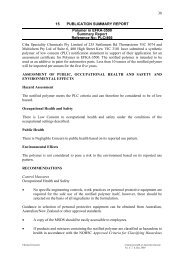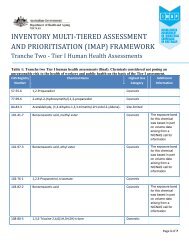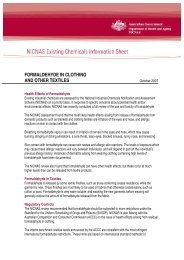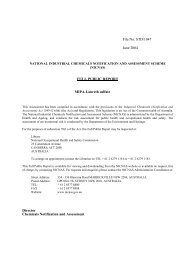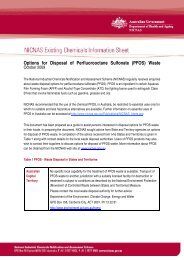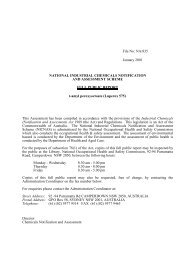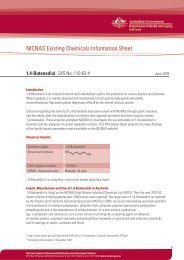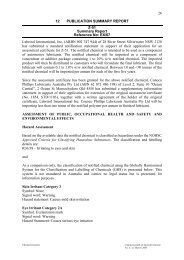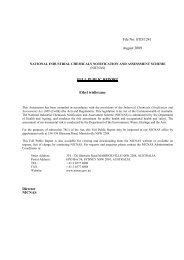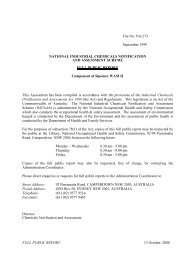GULFTENE C16-18 ISOMERISED OLEFINS - NICNAS
GULFTENE C16-18 ISOMERISED OLEFINS - NICNAS
GULFTENE C16-18 ISOMERISED OLEFINS - NICNAS
You also want an ePaper? Increase the reach of your titles
YUMPU automatically turns print PDFs into web optimized ePapers that Google loves.
<strong>18</strong> and are automatically discharged overboard through a pipe set a little below the sea surface<br />
but far above the sea floor.<br />
While most of the drilling mud is recovered in this manner, it is inevitable that some will<br />
remain adsorbed on the surface of the cuttings and may be entrained between the particles of<br />
solid waste and will be discarded with these cuttings. All drilling fluid, other than that<br />
adsorbed to the drill cuttings, is recovered and recirculated through the drill string on a<br />
continuous basis. No whole drilling fluid is discharged overboard. At the end of the drilling<br />
phase all the drilling fluid is recovered and returned to shore for storage until required on<br />
another well. It is important to note that stringent procedures are used to ensure that there is<br />
no loss of whole drilling fluid to the environment at any stage of the drilling and transport<br />
operations. Drilling fluids adhering to the disposed cuttings may constitute up to 10% by<br />
weight of the cuttings.<br />
6. OCCUPATIONAL EXPOSURE<br />
6.1 NUMBER AND CATEGORY OF WORKERS<br />
Import and Transportation: unknown;<br />
Drill mud preparation: 2 to 3 workers;<br />
Drilling crew: approximately 20 workers per offshore platform.<br />
6.2 NATURE OF WORK DONE<br />
Dockside and Transport<br />
Occupational exposure is not expected except in the event of a spill.<br />
Drill Mud Preparation<br />
Using automated systems, operators blend Gulftene 16-<strong>18</strong> with other components to produce<br />
the drilling mud as described in Section 5. Preparation of the mud takes about one to two<br />
hours depending on batch size. During preparation, potential for dermal and ocular contact to<br />
Gulftene 16-<strong>18</strong> at 33 to 50% exists for workers sampling the drilling mud for quality control<br />
(QC) analysis. Exposure to Gulftene 16-<strong>18</strong> may also occur during maintenance of equipment<br />
or in the event of a spill. Formation of aerosol and consequent inhalation exposure is<br />
expected to be negligible given the automated addition systems and the high density of the<br />
drilling muds.<br />
Drilling<br />
The large size of drilling equipment suggests that drill operators will have potential for<br />
exposure to high volumes of drilling mud during manipulation of the drill when the drill bit is<br />
replaced or removed from the drill hole. There is potential for skin and eye contact during<br />
these activities. Formation of aerosol and consequent inhalation exposure is expected to be<br />
negligible given the high density of the drilling mud.<br />
FULL PUBLIC REPORT 26 April 2000<br />
NA/713 Page 9 of 100



